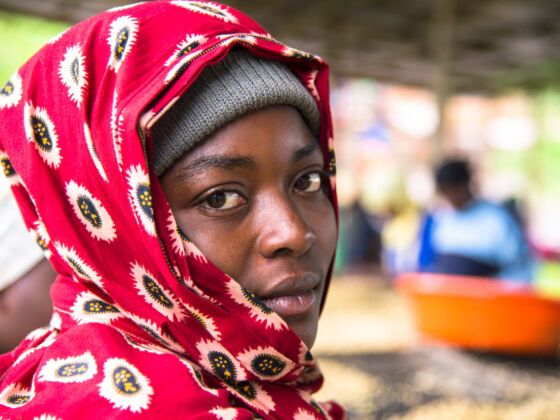It’s Saturday, and two women are dusting the skulls. Sun streams through afternoon clouds. Rain patters on the red dirt road. The sky is at once bright prisms and dark stratus swirls, and the duality is raw and promising. The women bend over shelves of bones inside the tin-roofed memorial site, pausing occasionally to look out over Rwanda’s rolling hills.


Down the road, the church choir is rehearsing, a gospel harmony streaming out of a brick-walled house. I pause on the roadway to listen.
“Keza?” an old man asks me, stopping alongside to adjust his knee-high rubber boots. Beautiful, no?
“Keza,” I agree. Beautiful.
We stand for a minute longer, the man and I, and he begins to murmur along with the hymn. As the music concludes, he extends his hand.
“Amahoro. Murakaza neza Kibeho,” he offers. Peace. Welcome to Kibeho.
Signs just outside Kigali, Rwanda’s capital, begin directing you to Kibeho, “The Holy Land.” As you get off the bus in town, a signpost orients you to the memorial site where victims of Rwanda’s 1994 genocide rest. Small painted markers point down to the valley spring where visions of the Virgin Mary occurred. Hand-lettered notices advertise cell phone credit, bus ticket sales, and chapatti at the local canteen. Up the hill, a banner declares the opening of a Catholic hotel, where portraits of Jesus, and, a little higher up, Rwanda’s President Kagame, decorate the walls.
Kibeho is a place of spiritual visions, of genocide memorial, of fields of cabbage, and a new bus line, and home to a little girl that, yesterday, learned to walk. It is also the site of a massacre, the Kibeho Massacre, which occurred in April 1995. Here, soldiers of the Royal Patriotic Front, the army President Kagame commanded and which brought a celebrated end to the 1994 genocide amidst international inaction, killed a contested 330 to 4,000 people.
There are no signs for that.
Walking about Kibeho, I often am reminded about the selectivity we use in recounting our stories and pasts. Where I am from, in the United States, dialogue on race and religion is often punctuated by conspicuous quiet. While events may pass concretely, their legacies stretch into the present, malleable by the language — and silence — with which we pass them on.
As I took my seat on the concrete bleachers I looked around, searching for a word to describe my surroundings. More than any one emotion, the plurality hit home. Swaddled toddlers yammered at their mothers for a bite of mandazi, a fried bread treat. Schoolchildren sought out their friends.
A wiry teenaged boy tried to steal a kiss; not here, the girl elbowed him. Grey-haired men sat straight-backed. In the soccer field below, a half dozen heads-of-state waited to speak.
The ceremony centered on a dramatic performance depicting the persecution of Tutsis during the 1994 genocide and the resurrection of Rwanda by the Rwandan Patriotic Front. Soldiers touched fallen actors, and their silver sashes flowing, spirit-like, they rose, uniting in the center of the field. The score from the army band soared: one Rwanda.
As I watched the performance, the story’s choreography stood out. It was so linear, so tidy. I admire pieces of educational drama for their ability to reach wide audiences and to begin difficult conversations, and acknowledge that the purpose of the performance was not to sketch a complete account of events.
Yet, I couldn’t escape the feeling that the presentation narrowed Rwanda’s history to such a finite and fine-tuned narrative that it forwent much of the complexity that offers powerful learning. As people we’re not tidy, and our histories, like us, are human, sometimes grotesquely so.
Riding back to Kibeho from Kigali on the bus afterwards, I sat next to a young man who struck up a conversation. “We remember in Rwanda,” he said. “But this week we, Rwandans, remember in other places, too. My family is in Uganda; they are refugees. They are waiting to come home. They were not mentioned in the speech.” I nodded.
I am an outsider, and as such my job is often first to listen and to learn. Each time I am told a new story, I realize how much I don’t know. I couldn’t possibly know. I don’t know how you construct a lasting external peace when many continue to endure emotional and violent inner turmoil.
I have been wholly impressed by the reconstruction and emergence of a new national identity, much of which requires perseverance beyond my own experience or comprehension. I am often in awe.
When the young man stopped speaking, I settled back in my chair. Many genocide perpetrators fled to refugee camps, I knew; yet many who also lived there were victims, or had fled in a long series of previous violent eruptions. Did this man’s family flee in fear of their lives? Of prosecution? I didn’t know. What I did know was that today he felt his story was not included in the national narrative presented.
Reflecting on the stadium performance, I wondered at the number of voices muted, like this young man’s, in the tidy fanfare of the united army band. What pieces — necessarily, dangerously? — had been edited out of the history commemorated and passed forward?